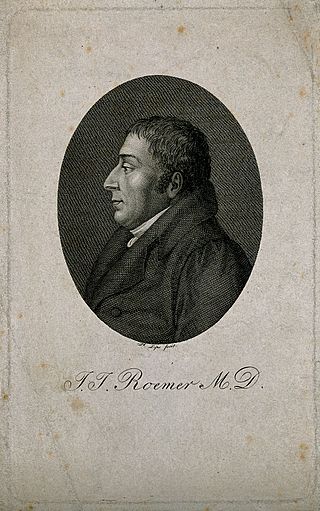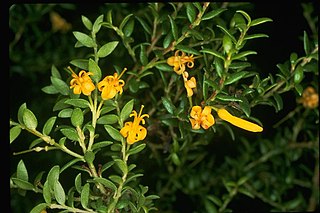
Carl Linnaeus, also known after ennoblement in 1761 as Carl von Linné, was a Swedish biologist and physician who formalised binomial nomenclature, the modern system of naming organisms. He is known as the "father of modern taxonomy". Many of his writings were in Latin; his name is rendered in Latin as Carolus Linnæus and, after his 1761 ennoblement, as Carolus a Linné.

Order is one of the eight major hierarchical taxonomic ranks in Linnaean taxonomy. It is classified between family and class. In biological classification, the order is a taxonomic rank used in the classification of organisms and recognized by the nomenclature codes. An immediately higher rank, superorder, is sometimes added directly above order, with suborder directly beneath order. An order can also be defined as a group of related families.

Johann Friedrich Gmelin was a German naturalist, chemist, botanist, entomologist, herpetologist, and malacologist.

Systema Naturae is one of the major works of the Swedish botanist, zoologist and physician Carl Linnaeus (1707–1778) and introduced the Linnaean taxonomy. Although the system, now known as binomial nomenclature, was partially developed by the Bauhin brothers, Gaspard and Johann, Linnaeus was first to use it consistently throughout his book. The first edition was published in 1735. The full title of the 10th edition (1758), which was the most important one, was Systema naturæ per regna tria naturæ, secundum classes, ordines, genera, species, cum characteribus, differentiis, synonymis, locis, which appeared in English in 1806 with the title: "A General System of Nature, Through the Three Grand Kingdoms of Animals, Vegetables, and Minerals, Systematically Divided Into their Several Classes, Orders, Genera, Species, and Varieties, with their Habitations, Manners, Economy, Structure and Pecularities".

Josef (Joseph) August Schultes was an Austrian botanist and professor from Vienna. Together with Johann Jacob Roemer (1763–1819), he published the 16th edition of Linnaeus' Systema Vegetabilium. In 1821, he was elected a foreign member of the Royal Swedish Academy of Sciences. He was the father of Julius Hermann Schultes (1804-1840).
Julius Hermann Schultes was an Austrian botanist from Vienna. He co-authored volume 7 of the Roemer & Schultes edition of the Systema Vegetabilium with his father Josef August Schultes (1773-1831).

Johann Jacob Roemer was a physician and professor of botany in Zurich, Switzerland. He was also an entomologist.

Supplementum Plantarum Systematis Vegetabilium Editionis Decimae Tertiae, Generum Plantarum Editiones Sextae, et Specierum Plantarum Editionis Secundae, commonly abbreviated to Supplementum Plantarum Systematis Vegetabilium or just Supplementum Plantarum, and further abbreviated by botanists to Suppl. Pl., is a 1782 book by Carolus Linnaeus the Younger. Written entirely in Latin, it was intended as a supplement to the 1737 Genera Plantarum and the 1753 Species Plantarum, both written by the author's father, the "father of modern taxonomy", Carl Linnaeus.
Eleocharis geniculata is a species of spikesedge known by several common names, including bent spikerush and Canada spikesedge. This is a widespread plant of wet areas in the Americas, Asia, Africa, Australia, Madagascar, and some Pacific Islands. It is an annual spikesedge growing to a maximum height of about 40 centimeters. It has a few straw-colored leaves and many thin erect stems. The stems hold inflorescences of rounded spikelets each containing at least 10 tiny flowers. The flowers are covered with dark greenish-brown bracts. The fruit is a shiny purple-brown achene not more than a millimeter long.

Eleocharis palustris, the common spike-rush, creeping spike-rush or marsh spike-rush, is a species of mat-forming perennial flowering plants in the sedge family Cyperaceae. It grows in wetlands in Europe, North Africa, northern and central Asia and North America. Eleocharis palustris is not easily distinguished from other closely related species and is extremely variable worldwide itself. The species epithet palustris is Latin for "of the marsh" and indicates its common habitat.

Coleanthus is a genus of Eurasian and North American plants in the grass family. The only known species is Coleanthus subtilis. It has a scattered distribution, found on lakeshores, streambanks, and other wet places in central Europe, Asia, and northwestern North America.

Tripogon is a genus of tropical and subtropical plants in the grass family. They are widespread across Asia, Africa, Australia, and the Americas. Fiveminute grass is a common name for plants in this genus.

The bibliography of Carl Linnaeus includes academic works about botany, zoology, nomenclature and taxonomy written by the Swedish botanist Carl Linnaeus (1707–1778). Linnaeus laid the foundations for the modern scheme of binomial nomenclature and is known as the father of modern taxonomy. His most famous works are Systema Naturae which is considered as the starting point for zoological nomenclature together with Species Plantarum which is internationally accepted as the beginning of modern botanical nomenclature.

Persoonia oxycoccoides is a species of flowering plant in the family Proteaceae and is endemic to New South Wales. It is a spreading to prostrate shrub with smooth bark, hairy young branchlets, elliptic to egg-shaped leaves and yellow flowers arranged in groups of up to thirteen along a rachis that continues to grow after flowering.

Johan Andreas (Anders) Murray was a Swedish physician of German descent and botanist, who published a major work on plant-derived medicines.
Eleocharis tuberculosa, the cone-cup spikerush, is a plant species native to the United States and Canada. It has been reported from every state on the Gulf and Atlantic coasts from Maine to Texas, plus Kentucky, Tennessee, Arkansas and Nova Scotia. It is found in wet soil in meadows, woodlands, lake shores and river banks.
Allium delicatulum is a Eurasian species of onion native to European Russia, Western Siberia, Xinjiang, and Kazakhstan. It grows in open grasslands and deserts.
Pinillosia is a genus of Caribbean plants in the cosmos tribe within the daisy family.
Veronica brownii is a plant belonging to the family Plantaginaceae native to New South Wales in Australia, where it is restricted to the Blue Mountains. It has arching branches with variable shaped leaves and lilac flowers in spring and summer.

Schoenus pedicellatus is a species in family Cyperaceae, first described by Robert Brown in 1810 as Chaetospora pedicellata, but assigned to the genus, Schoenus, in 1811 by Jean Louis Marie Poiret. Note that GBIF and Plants of the World Online both give the genus change as being by Roem. & Schult. However the species is Australian and the text by Poiret is earlier than that of Roemer and Schultes.















